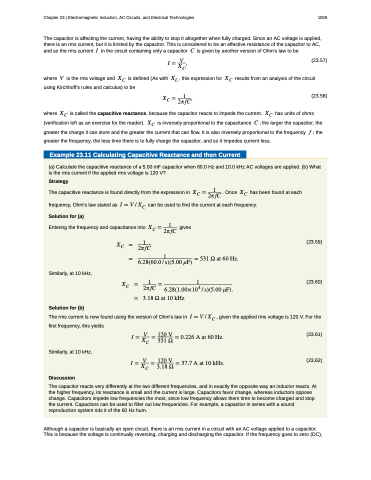Page 1071 - College Physics For AP Courses
P. 1071
Chapter 23 | Electromagnetic Induction, AC Circuits, and Electrical Technologies 1059
The capacitor is affecting the current, having the ability to stop it altogether when fully charged. Since an AC voltage is applied, there is an rms current, but it is limited by the capacitor. This is considered to be an effective resistance of the capacitor to AC, and so the rms current � in the circuit containing only a capacitor � is given by another version of Ohm’s law to be
� � �� � (23.57) �
where � is the rms voltage and �� is defined (As with �� , this expression for �� results from an analysis of the circuit using Kirchhoff’s rules and calculus) to be
��� � � (23.58) �� ��
where �� is called the capacitive reactance, because the capacitor reacts to impede the current. �� has units of ohms (verification left as an exercise for the reader). �� is inversely proportional to the capacitance � ; the larger the capacitor, the greater the charge it can store and the greater the current that can flow. It is also inversely proportional to the frequency � ; the greater the frequency, the less time there is to fully charge the capacitor, and so it impedes current less.
Example 23.11 Calculating Capacitive Reactance and then Current
(a) Calculate the capacitive reactance of a 5.00 mF capacitor when 60.0 Hz and 10.0 kHz AC voltages are applied. (b) What is the rms current if the applied rms voltage is 120 V?
Strategy
The capacitive reactance is found directly from the expression in �� � � . Once �� has been found at each �� ��
frequency, Ohm’s law stated as � � � � �� can be used to find the current at each frequency. Solution for (a)
Entering the frequency and capacitance into �� � �� � �
Similarly, at 10 kHz,
Solution for (b)
� �� ��
gives
�
� ��� � �� �� ���
�� ��
��������� � ������� ���
(23.59)
(23.60)
�
�� � � � �
�� �� ������������� � ������� ���� � ������������
The rms current is now found using the version of Ohm’s law in � � � � �� , given the applied rms voltage is 120 V. For the first frequency, this yields
Similarly, at 10 kHz,
Discussion
�� � ������������������� �� ��� �
�� � � ���� �������������� �� ���� �
(23.61)
(23.62)
The capacitor reacts very differently at the two different frequencies, and in exactly the opposite way an inductor reacts. At the higher frequency, its reactance is small and the current is large. Capacitors favor change, whereas inductors oppose change. Capacitors impede low frequencies the most, since low frequency allows them time to become charged and stop the current. Capacitors can be used to filter out low frequencies. For example, a capacitor in series with a sound reproduction system rids it of the 60 Hz hum.
Although a capacitor is basically an open circuit, there is an rms current in a circuit with an AC voltage applied to a capacitor. This is because the voltage is continually reversing, charging and discharging the capacitor. If the frequency goes to zero (DC),


